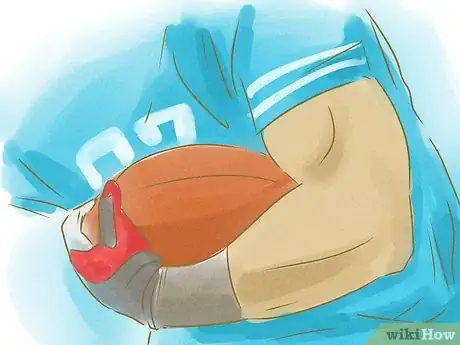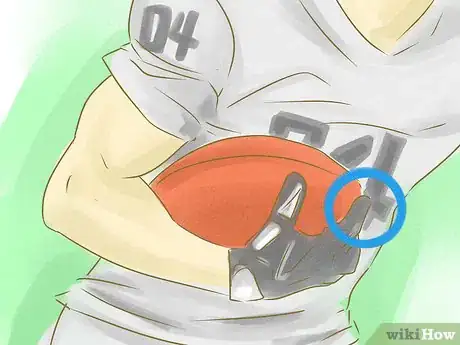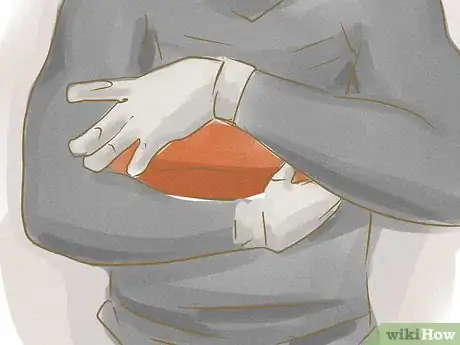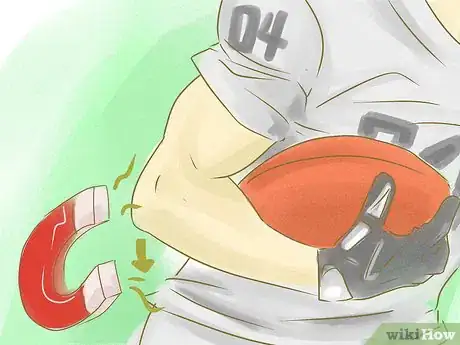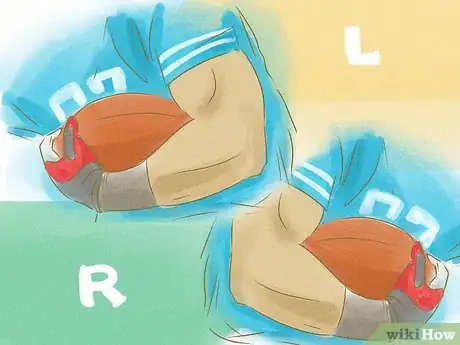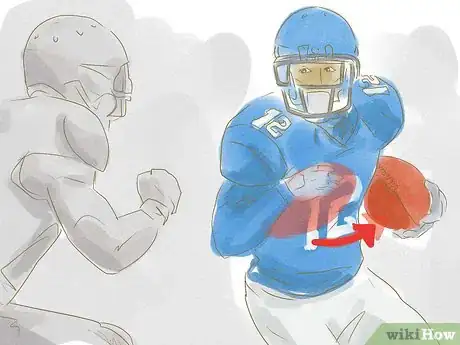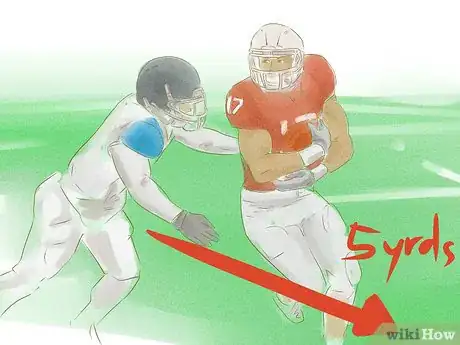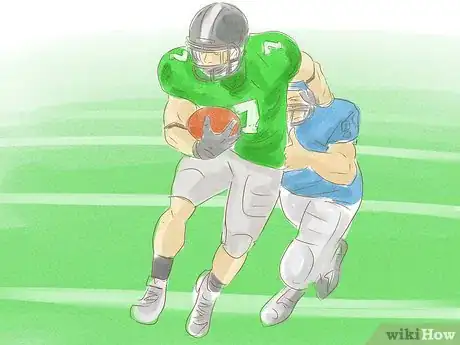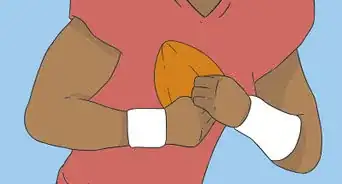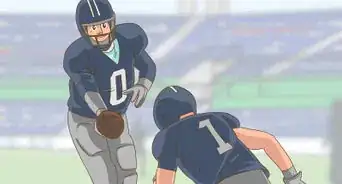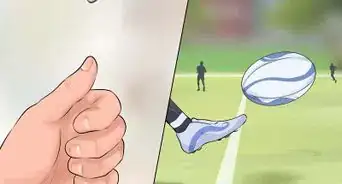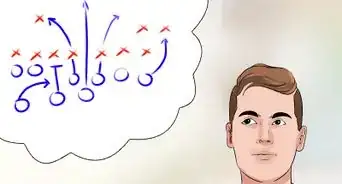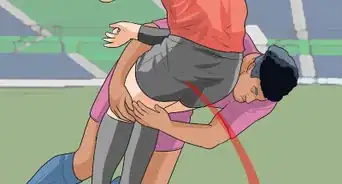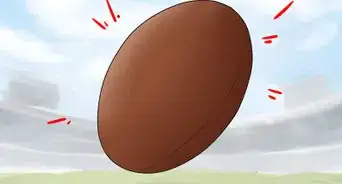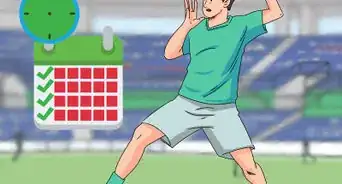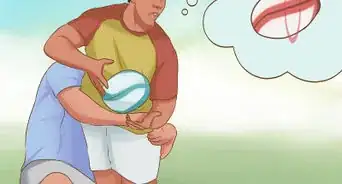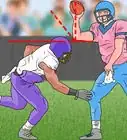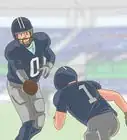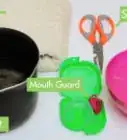wikiHow is a “wiki,” similar to Wikipedia, which means that many of our articles are co-written by multiple authors. To create this article, 17 people, some anonymous, worked to edit and improve it over time.
There are 8 references cited in this article, which can be found at the bottom of the page.
This article has been viewed 57,045 times.
Learn more...
Learning to carry the football properly will help to reduce the possibility of fumbles and will make you a better football player. Whatever position you play, doing ball-handling drills is an important part of any practice routine. You can learn the proper technique and the proper running drills to help you improve your game.
Steps
Carrying the Football
-
1Place the point of the ball in your palm. To hold the ball properly, hold your dominant or writing hand palm-side up and put one point of the ball into your palm so the length of the ball is even with your forearm. It doesn't matter which end of the ball you put in your hand, or where the laces are when you're holding the ball, but it does need to be positioned securely.[1]
- If you want to learn to hold the ball for throwing, the technique will be slightly different. Learn how to throw a football properly by clicking here.
-
2Put your finger on the point of the football. To seat the ball properly and tuck it, put your index finger on the very tip of the ball and bring it to rest even against the inside of your forearm. The ball should be seated so you can wrap your fingers around the part of the ball that starts to taper to the point, wresting it against your wrist.[2]
- Alternatively, some players like to rest the point between two fingers, either the index and middle or the middle and ring. For some, this is a comfortable way of securing the ball, while it feels awkward for others. Experiment and see if it feels right for you.
Advertisement -
3Curve your wrist so the side of the ball is resting against it. Your arm should mimic the natural curve of the ball, bending your wrist to seat the ball in the "pocket" of your forearm, wrist, and shoulder firmly. To support the underside of the ball, curve your wrist, grip it firmly with your fingers, and hold it against your arm.[3]
- It’s important that you use your whole arm to support the weight of the ball, not primarily using your hand or the strength in your fingers. That's a good way to get the ball stripped and fumble.
-
4Tuck the ball. Hold the ball against your chest on one side of your body, above your ab muscles but below your pecs, keeping your elbow as close to the side of your body. This ensures great ball control with little chance of losing grip because of a defender.[4]
-
5Wrap up the ball. With your other hand, cover the ball as if you were protecting a delicate object and trying to keep it safe. When you're running in traffic, it's important to use every angle of your body to shield the ball and keep it from prying hands. Cover up the ball as much as possible with your other hand.[5]
- When you’re running for speed, you can use your other arm to pump and move forward, carrying you with momentum and helping you balance, but when you move in traffic you’ve got to wrap it up.
Running With the Football
-
1Practice holding drills, regardless of the position you play. A lot of coaches say this may be the single most important drill they do for ball carrying. Quarterbacks, running backs, cornerbacks, safeties, tight ends and receivers–all plays who touch the ball should all practice holding the ball and drill regularly in ball-handling skills. If there's any possibility that you'll ever end up with the ball in your hands, you need to learn to hold it properly.
- Ball-handling drills don't need to be complicated and you can do them in conjunction with other conditioning exercises. Try running tires while you're holding the ball, or running stairs while you're holding the ball. Do any drill that doesn't require hands with a ball in your hands.[6]
-
2Keep your elbows tucked in. However well you've trained and coached, one thing happens to a lot of beginning players: as soon as you start running, the technique goes out the window. Your elbows pop out, the ball flails around your body, and often comes loose. While this partially comes with experience, there's one little trick to help keep you from fumbling. Keep your elbows in tight to your body and the ball will be more secure.
- When you run with the football, pretend there's a magnet that's pulling your elbow toward your hip. This will help to pocket the ball more securely and keep you from flailing as you might be inclined to do. It'll be automatic eventually.
-
3Practice carrying with both arms. Good football players can carry the ball just as securely in both arms, so it's important to spend as much if not more time drilling with the ball in your non-dominant hand to build the skills necessary for good ball-handling.
- This is especially important for running backs, who generally want to pocket the ball in the arm closest to the sideline, or in the direction of travel. In other words, if you're cutting to the left, you usually want to carry the ball in your left hand to keep it away from defenders.
-
4Practice switching the ball to the outside. Football's a crazy game and you've got to learn to adapt to the play as it changes and adapt to the defense as they shift. Generally, you want to switch the ball to the side of your body farthest away from defenders and closest to the sideline, to protect it as much as possible. Put your body between the defender and the ball.
- Practice shifting the ball but keeping it tight and secure as possible. The ball should be touching your torso at all times as you shift your arm, then cover the ball with both arms like you're hugging it, then take control of the ball with your other arm and move it over. Don't juggle it between your hands.
- If you’re running toward the sideline, you want the ball to be as close to the sideline as possible so that, should you fumble, the ball is more likely to go out of bounds so your team will retain possession.
-
5Do ball wrestling drills. To practice getting stronger and securing the ball in contention with defenders, it's common to practice ball wrestling drills as a way of getting players to hold the ball more firmly. Whether you do this as part of football practice or not, it can be a great way of improving your skills with a friend or two.
- Pair up, one ball-handler and one defender. The runner will hold the ball securely while the other player will get a hand on it, running in tandem and trying to rip the ball away for a distance of five yards. At the five yard cone, the defender should make one last big rip at the ball, at which time the ball carrier should secure it and accelerate five more yards to finish the drill.
- It's important to finish strong, focusing on keeping the ball running moving forward and powering past the defender. The drill doesn't end when the player holds the ball, it ends with a power-up spring through to the finish.[7]
-
6Practice hold the runner drills. Another popular ball-handling drill that will help you avoid turnovers is a lot like the ball-wrestling drill, and can be practiced with two players. The runner will secure the ball firmly and run five yards while a defender positions just behind the runner, with his hands on the runner's hips. The defender will shuffle and try to hold the runner back during the drill, then swipe at the ball just before the five yard marker. After securing the ball, the runner should power through for another five yards.[8]
Community Q&A
-
QuestionCan everyone play football?
 Community AnswerAs long as you do not have a major physical disability that may impact your ability to play football, everyone can have the potential to play football.
Community AnswerAs long as you do not have a major physical disability that may impact your ability to play football, everyone can have the potential to play football. -
QuestionHow can I be a good wide receiver?
 DonaganTop AnswererYou need to be a fast and agile runner, have good hands, and be able to jump high and hold on to the ball when you're hit hard. Learn to catch the ball at the sideline. Be able to catch it even when you know you're about to be hit. Become a good downfield blocker. Be able to improvise when the quarterback has to scramble.
DonaganTop AnswererYou need to be a fast and agile runner, have good hands, and be able to jump high and hold on to the ball when you're hit hard. Learn to catch the ball at the sideline. Be able to catch it even when you know you're about to be hit. Become a good downfield blocker. Be able to improvise when the quarterback has to scramble.
Warnings
- Whenever playing football, wear padding.⧼thumbs_response⧽
Things You'll Need
- A football
References
- ↑ https://blogs.usafootball.com/blog/3965/how-to-properly-grip-a-football
- ↑ http://www.footballbabble.com/blog/football/how-to-carry-a-football/
- ↑ http://footballuniversity.org/technique-tuesday-running-backs-carrying-the-football/
- ↑ https://www.stack.com/a/how-to-carry-a-football
- ↑ https://www.ducksters.com/sports/football/how_to_tackle.php
- ↑ https://www.youtube.com/watch?v=_-UDxA5ztD8
- ↑ http://www.football-tutorials.com/ball-carrying-football-drills/2737/
- ↑ https://www.football-tutorials.com/hold-the-runner-ball-security-drill/
About This Article
To hold a football, put one point of the ball into the palm of your dominant hand so that the length of it goes down your forearm. Then, to ensure that the ball is secure, put your index finger on the tip of the football so your fingers can wrap around the ball where it starts to taper. Since your whole arm should support the ball’s weight, curve your wrist so your arm mimics the ball’s natural curve. You should also hold the football against one side of your chest, keeping your elbow close to your side, so that there’s less chance of losing grip on it. For more help, including how to run with the football, read on!
